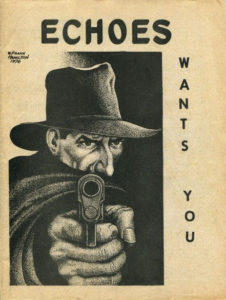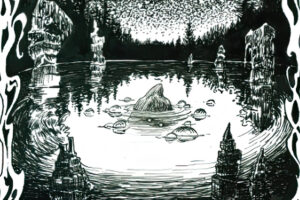 I’ve posted several articles on specific pulp fanzines, and have plans for more, but I wanted to do an overall posting on them. Probably should have done this first.
I’ve posted several articles on specific pulp fanzines, and have plans for more, but I wanted to do an overall posting on them. Probably should have done this first.
Fanzines are an interesting aspect of fandom in many areas. Fanzines are “fan magazines,” magazines done by fans for fans, as opposed to other fan magazines that are produced for fans, but by commercial concerns, like official fan clubs and the like. Pulp fanzines have a long history, most growing out of science fiction fandom, as much of the early science fiction existed only in the pulps.
The production values of fanzines vary wildly. At the beginning, many were mimeographed and later photocopied, stapled by the publisher (who was also the editor and often the main contributor to the fanzine), and mailed out to subscribers. Some fanzines might be professionally printed, but limited to newsprint paper, maybe with higher quality paper for the covers, which may be black and white, sometime one color, and rarely full color. As technology improved, fanzines could be color photocopied or more likely be professional printed and published on high-quality or slick paper with color covers and maybe color interiors (or a few pages anyway), bound and trimmed instead of just folded and stapled. Desktop publishing also had an effect on fanzines, improving their production from when they were just typed. Fanzines were either letter-sized or folded letter-sized. With print on demand, this has improved fanzines further, allowing many to be more professionally printed. An added benefit is with print on demand, they never need to go “out of print”.
The genres of the fanzines can vary as well. Some were just general pulp fanzines, covering any genre, while others might focus on just hero pulps or a certain hero (usually either Doc Savage or The Shadow), or certain authors like Edgar Rice Burroughs, Robert E. Howard, or H.P. Lovecraft. As some characters and authors had fans outside of the pulp fandom, these fanzines often had a wider range of audience.
Another difference in fanzines is what they published. Some fanzines published only articles, some had articles and fiction (either new or old), some only fiction (again, either new or old). Some were “letter zines,” publishing only letters from subscribers. Other fanzines may or may not include letters. Another type were “adzines,” publishing only ads and sales lists. Many fanzines ran ads as a way to offset costs, but adzines only had ads. A few fanzines sadly went to only adzines during their life.
Another type of fanzines are the amateur press associations (APAs), which was where a number of contributors create their own fanzine, send a set of copies to a compiler who pulls all the various contributed fanzines together and sends them out to everyone. Pulp Era Amateur Press Society (PEAPS) is the one I know of for the pulps. It’s still being published. Hopefully I can post on that one at some point. Unlike your regular fanzines, as I understand it, the APAs are only sent to the contributors. There are no subscriptions to non-contributors, so the only way to obtain copies would be if a contributor decided to sell some of his copies.
While some fanzines lasted only a few issues, there were several that lasted many issues for many years. It’s sad that many great fanzines have fallen to the wayside. I only know a few that still remain. Bronze Gazette is going strong, Blood ‘n’ Thunder has transformed to a series of books, Pulpdom continues but as an online endeavor (Pulpdom Online #19 should be out shorty).
Not quite fanzines are the program books for Pulpfest and the Windy City Pulp Convention, but are very nice.
Long gone are the greats such as Echoes, Golden Perils, Nemesis, Inc, Purple Prose, Pulp Collector, Pulp Vault, and Xenophile, not to mention the many shorter lived ones. Sadly, few of these have I posted on because I don’t have complete or near complete sets yet. Fiction-only zines remain such as High Adventure and Pulp Adventures, along with other newcomer zines such as Skelos, Cirsova, and Occult Detective Quarterly. I have been working on a list of pulp fanzines, the number of issues, and when they were published. I am also working on a chronological listing of them that may be shared at some point.
I am still working to fill in my collection of pulp fanzines and if anyone can help, please do. One thing I wish would happen is for someone to take on the effort of scanning these fanzines to help make them available for posterity. They should be preserved.
Getting back issues, especially of the defunct zines are difficult. Of the current ones, back issues of Pulpdom is available from the publisher at $1 each, in PDF format. Blood ‘n’ Thunder will be making their issues since #21 available soon in a new print on demand format of 3 issues each per volume. For others being currently published, check out their publishers. For the defunct ones, you’ll need to check with the dealers out there.
Many pulp researchers have contributed important articles in these zines over the years, but only a few have been collected into books, most of which I’ve reviewed here. With several of these people, such as Al Tonik, passing away, their works need to be preserved for future, if not the current, generation to read and treasure. Even creating indexes for these fanzines would be important. Pulpdom makes its index available at its website. I have seen indexes for some of the other fanzines, but none available online, and many fanzines are left out.
Look for my upcoming postings on more pulp fanzines. Many more to come!




Michael, are you familiar with MYSTERY FANFARE by Michael L. Cook. It indexes mystery and related fanzines from 1963 to 1981. It’s available on Amazon at https://www.amazon.com/Mystery-Fanfare-Composite-Annotated-Fanzines/dp/0879722304/ref=sr_1_1?s=books&ie=UTF8&qid=1527290278&sr=1-1&keywords=mystery+fanfare+by+michael+l.+cook
Nope, wasn’t aware of this, but will look into it.
Ordered what may be the last copy at Amazon. Hope its worth it.
What about Spicy Armadillo Stories? In my experience, that is one of the hardest to find fanzines.
Wasn’t trying to cover them all. But sadly, don’t have any copies myself.
i don’t understand why you say windy city pulp stories is not a fanzine : it is , it’s different program convention ( i have windy numbers , i don’t know for pulpfest , i don’t have numbers …. for the moment 🙂 )
i suppose you know the 800 fanzines in hevelin collection
http://hevelincollection.tumblr.com/
I said they are “not quite fanzines” as they are convention program books, not that they weren’t fanzines. They are a little different.
If you had read my blog, you’d see I’ve been reviewing both The Windy City Pulp Stories and Pulpster for some time. I just reviewed the 18th WCPS earlier this month, and when I get my hands on this year’s Pulpster (#27), I’ll be reviewing that one as well.
Was not familiar with the hevelin collection, but I see that its sf fanzines, no pulp fanzines. I’d love to see something like this done for the many pulp fanzines I mentioned and all the rest.